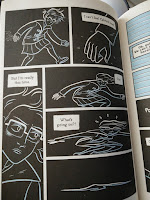A Wrinkle in Time. The Graphic Novel by Madeleine L'Engle & Hope Larson (2012)
, 22 April 2017
This is a graphic adaptation of L'Engle's classic book, originally published in 1962. It tells the story of siblings Meg & Charles who, with their recently befriended Calvin, start an unintended time-travel adventure in search of the siblings long-time missing physicist father, Dr Murray.
If you grew up with this novel, you will certainly approach this graphic adaptation and the whole reading experience very differently from how I approached it, as I read this novel as an adult and have no childhood emotional attachment to it.
The first thing I noticed about this novel, unaware of the original publication date, was that the kids and society shown in the story don't know the Internet, don't have mobile phones, tablets or super-duper gadgets, something that millennial kids might find odd. However, this novel is wonderfully imaginative, fun, and is embedded with values and lessons of which any pre-teen or early teen will benefit:
> It is OK to be different, you have to accept yourself the way you are right now.
> You should not care about what other people think of you, and don't give them power over your own inner voice to dictate your self-worth.
> Having a family that is different from the norm is OK, as long as the family unit is filled with love and the right values.
> Having a family that is different from the norm is OK, as long as the family unit is filled with love and the right values.
> You have to learn to accept your part of responsibility for your own actions.
> Part of growing up involves you loving your parents but also finding a voice that's distinct and separate from them.
> Sometimes you have to trust people who are more mature than you, and need to believe that they know better.
> When you grow up, risk-taking is unavoidable.
> When you grow up, risk-taking is unavoidable.
> You have to learn to be an individual, still being part of a community without giving too much power to your individuality or the power of the community.
> There are things in life that cannot be explained, but are real.
> There are things in life that cannot be explained, but are real.
The novel also captures things that are very important when growing up and approaching adulthood: the power of mateship, the value of trust, the first love, the importance of having a father and/or authority figure in your life. One of the most interesting parts of the novel is the visit to Planet Camazotz, as it teaches young readers important lessons: the difference between individuality and selfishness, the difference between a society in which the individuals are equal and have the same rights, and a society in which everybody is demanded to be and behave the same without deviation from a standard imposed over them; there is also a nice reflection on what true happiness is.
This is a science-fiction fantasy novel, so if I had read this in the 1960s, I would have been thrilled. However, this is year 2017 and it is a bit dated, to me. Science-fiction has had an amazing development and revolution since the book was written, mostly due to the proliferation of amazing original films, of our gaining knowledge about what is possible and impossible in Science, and because of the unbelievable world changes derived from the digital revolution. Modern readers have a more-scientific accurate idea of what time-travel implies, what makes possible life on other planets, and of other scientific facts that were unknown or poorly known at the time L'Engle wrote this book. Having said that, I found the concept of a five-dimensional Universe really brilliant. In the end, this is a fantasy novel, so let our imagination go wild and imagine the impossible.
I enjoyed the graphic adaptation of the book. I cannot comment on whether this is a good adaptation or not as I haven't read the original. The graphics are rendered in black, white and sky blue, which is a pity, because I thought this would have been a wonderful book to have it full colour, as the characters' facial expressions would have benefited and be more powerful, and some of the landscapes depicted would have been awesome in colour. However, Larson has captured the spirit of the novel, the characters' personality, and the 1960s flare. I especially loved Larson's rendering of Aunt Beast, the in-between time-travel transitions, and the depiction of events happening in the narrative past.
Overall, this is a lovely book for children approaching adulthood, as it is both fun and wise. As an adult reader, however, I found this graphic book OK, not too exciting and a bit outdated. If your experience is different, well, good on you :).
A feature film based on the novel will be released in 2018.


















Post a Comment
Comments are Moderated
Note: only a member of this blog may post a comment.